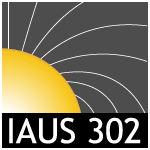The Bcool project is an international collaboration studying the magnetic activity of low-mass stars from pre-main sequence through to evolved objects. The project has a particular emphasis on the use of spectropolarimetric observations to characterise the magnetic fields of cool stars and improve understanding of the operation of stellar dynamos under a range of conditions.
As part of the Bcool project, over 150 solar-type stars chosen mainly from planet search databases have been observed between 2006 and 2013 using the NARVAL and ESPaDOnS spectropolarimeters on the Telescope Bernard Lyot (Pic du Midi, France) and the Canada France Hawaii Telescope (Mauna Kea, USA) respectively. These single "snapshot" observations have been used to detect the presence of magnetic fields on approximately one third of our sample, with the highest detection rates occurring for the youngest stars. From our observations we have determined the mean surface longitudinal field (or an upper limit for stars without detections) and the chromospheric surface fluxes, and we investigate how these activity measures relate to each other and to stellar parameters.
|
|
|
|
Tuesday
27
Session 2 - Magnetic activity in the Sun and main-sequence stars with convective outer layers
Chair: Stéphane Mathis › 11:50 - 12:10 (20min) A Bcool spectropolarimetric survey of over 150 solar-type stars
1 : University of Southern Queensland
(USQ)
-
Website
West Street, Toowoomba, Queensland, 4350 -
Australia
2 : Institut de recherche en astrophysique et planétologie
(IRAP)
CNRS : UMR5277, Observatoire Midi-Pyrénées, Université Paul Sabatier - Toulouse III
3 : Georg-August-Universität
4 : Universidade Federal do Rio Grande do Norte
(UFRN)
5 : University of Southern Queensland
(USQ)
|

 PDF version
PDF version
